Introduction :
The article of this site devoted to their reproduction mentions the courtship observed in some species of springtails. These nuptial dances attest, at the very least, to the existence of gestural communication probably using the tactile and/or visual perception of springtails. But it must be emphasized that the latter remains rudimentary, or even non-existent in some species. In this case, when the latter operate in environments without light or dimly lit, the exchange of information must take place in other forms. Even independently of these displays, which are not systematic, springtails can emit chemical substances to interact with their partner or potential partner.
The communication of springtails remains an area little explored by researchers, who have however lifted the veil on an arsenal of chemical communication used by all arthropods and not only in their reproductive phases.
A review article (1) published by a group of scientists prompted me to explore this field which presents a certain complexity, since one wishes to go into the details of the chemical and physiological processes involved. Ishall therefore reach an impasse on this point and shall confine myself to proposing diagrams of principle simply to refer to what we are talking about.
Olfactory perception:
Living organisms need to perceive information from their immediate environment in order to evolve and survive. For this, they use sensory faculties that allow them to interact with the latter. Sight or tactile sensitivity are part of this sensory arsenal but, in insects, it is the olfactory sense that most often allows them to identify the various chemical signals that reach them. The sensitivity and selectivity ofthe olfactory systems implemented in arthropods are particularly effective. A single molecule received makes it possible to induce a physiological and/or behavioral reaction.
Chemical receptors:
In arthropods, olfactory detection requires specific sensory organs. The latter are programmed to perceive chemical compounds or odorous molecules present in their environment. They can take different forms while maintaining a common architecture; whether they are located at the level of the antennae, sensilla or other structures, such as the post-antennal organ in some springtails.
Opposite is a diagram (2) of an antennal chemical receptor.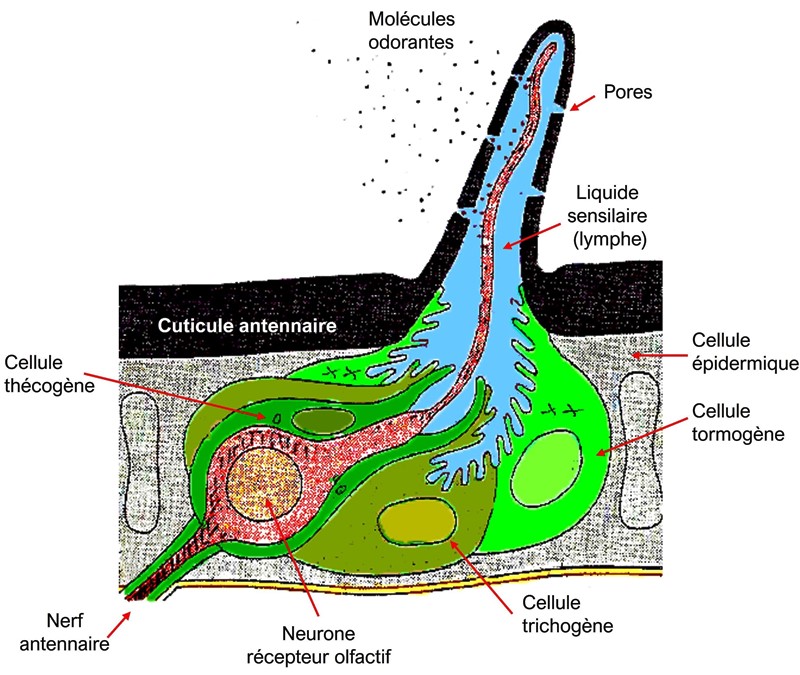
This cross-section shows odorous molecules that penetrate through the cuticular pores into the sensory lymph from which they will be in contact with the branching of an olfactory receptor neuron or dendrite (here in red) which will carry the information received to the antennal nerve in direct connection with the brain of the animal.
Each sensory receptor responds specifically to a molecule or family of chemical molecules that comes into contact with it. Based on this chemosensory specificity, the researchers highlighted several types of olfactory sensillas. Positioned on different parts of the arthropod's body, they react to odorous or guztogen molecules, but can also be sensitive to carbon dioxide, temperature, humidity or a combination of these different chemical modalities. The sensory repertoire of arthropods therefore presents a wide variety that responds precisely to the diversity of chemical stimuli and the infinite number of odorous and gustatory molecules possible.
Pheromones, vectors of communication:
In addition to theodorous substances naturally present in different environments, insects or other arthropods are able to communicate with each other by emitting their own chemical substances that we generically call "pheromones". These pheromones allow communication within the same species (intraspecific), while other chemical substances called ectomones, define relationships between different species (interspecific).
There are different types of pheromones: allomones that manifest themselves for the benefit of the transmitter and kairomones that are for the benefit of the receptor. The synomones that benefit both the transmitter and the receiver and the necromones that signal death.
For example, a dying bee produces linoleic acid which is immediately detected by its congeners specialising in cleaning the hive, which allows them to evacuate the corpse to the outside in order to avoid the health risk of its decomposition within the body.
- Sex pheromones are usually emitted by females to signify their readiness to be fertilized. Perceived by the males, they lead them to approach the female to initiate reproduction.
- The so-called aggregation pheromones, produced regardless of sex, are used to communicate to attract individuals of the same species to places with food resources but also conducive to reproduction, moulting or offering protection against external aggressions such as heat, which is a risk factor for dehydration to which some species are sensitive. Below (3), aggregation of springtails Podura aquatica where we can note the presence of many exuviae (moults) of white color.
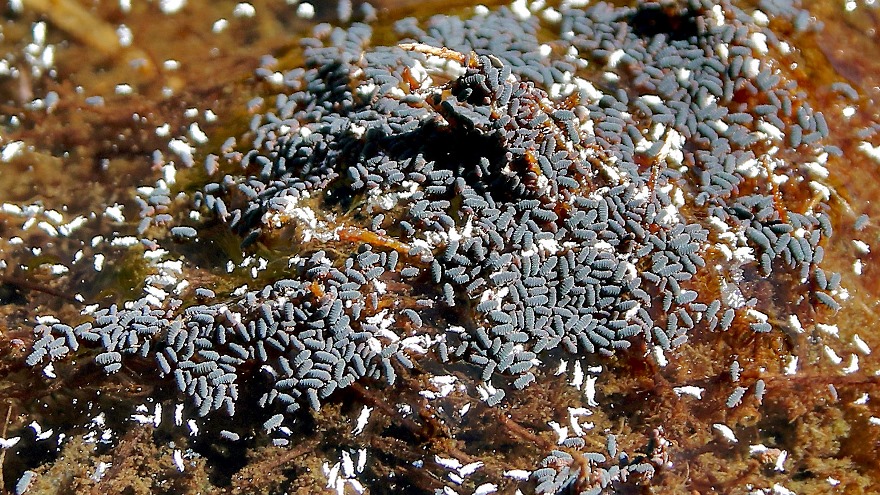
Note: A study(4) shows that for a certain number of species, the further apart they are on their phylogenetic tree, the less sensitive they are to their respective aggregation pheromones. Thus, for example, Pseudosinella alba shows a significant attraction to Pseudosinella decipiens pheromones. Similarly, Pseudosinella decipiens is attracted to Heteromurus nitidus which are genetically similar species. Whereas with more distant species, such as Heteromurus nitidus or Pseudosinella decipiens with Folsomia candida, no attraction was noted. It happens however that fairly close species are not attracted to each other, this is the case between Pseudosinella alba and Heteromurus nitidus. The researchers also noted a repulsion between very distant species, Arrhopalites caecus / Heteromurus nitidus (belonging to two distinct orders, respectively Symphypleone and entomobryomorphe). No conclusion therefore at this stage of study, but the hypothesis that the cross-attractions between springtails respond to a Darwinian evolution of their pheromones remains plausible and will find an answer as studies are conducted on this subject.
Below is an illustration of the morphologies of the five species studied: Pseudosinella alba and decipiens (A), Heteromurus (B), Folsomia (C), Arrhopalites (D) and their positions in an extract of the phylogenetic tree.

- The alarm pheromones produced more particularly to signal the presence of a danger, mobilize individuals of the same species, facing a predator or to overcome resistance on the part of a host. They are usually issued during attacks or injuries. This form of communication is easily observed when disturbing a very small area on an anthill and there is agitation of the entire colony over the entire surface of the anthill. It can also be experienced when you get too close to a hive and the defensive mobilization of bees manifests itself very quickly.
- Trace pheromonesmark a path. We have all observed ants evolving in columns (4) to go towards a food resource. The ant that discovers the presence of food takes care to mark its passage by depositing pheromones on the ground. The rest of the colony then only has to follow this chemical path to access the resource.
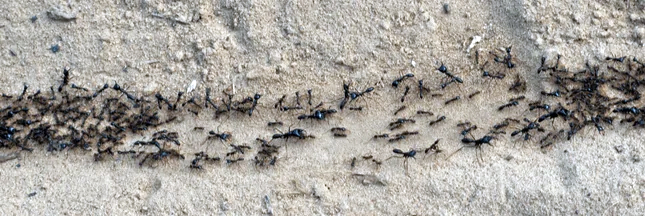
Chemoreceptors:
Olfaction is one of the essential elements of the nervous system of animals and more particularly in springtails. Arthropods, like vertebrates, have a similar organization of their olfactory system consisting of basic units that connect receptor neurons to the integrating centers of the brain.
The term olfactif can be confusing, because springtail does not have a nose like mammals. The sensors used by its receptor organs are chemoreceptors or ionotropic receptors that operate according to diagram (5) of principle below.
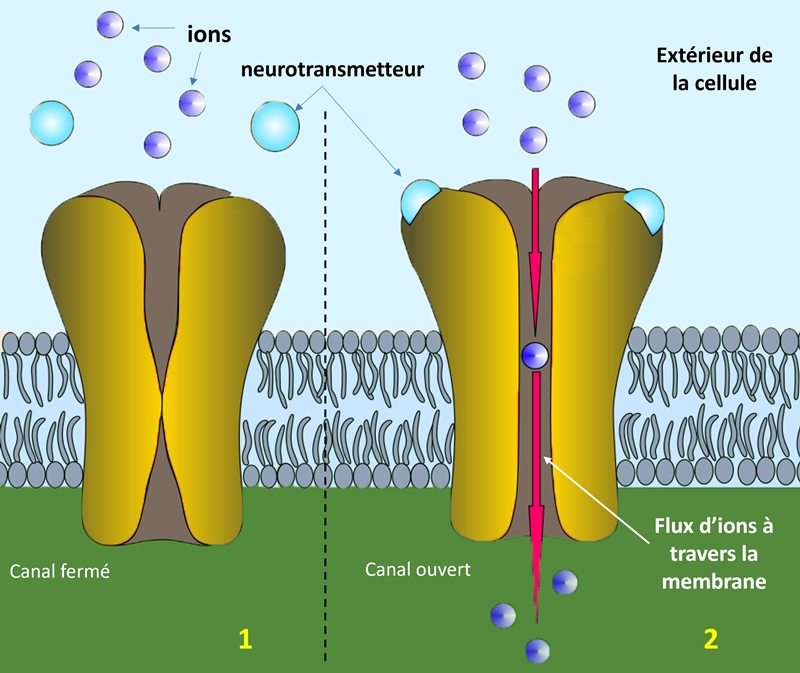 The ionotropic receptor is a membrane protein capable of converting a chemical message into an electrical message. This protein opens an ion channel through the binding of a chemical messenger (neurotransmetteur). This selective receptor is specialized to receive a particular type of ion such as sodium ion (Na+), potassium ion (K+), calcium ion (Ca²+) or chloride ion (Cl-). These transmembrane ion channels open or close in response to chemical messenger bonding.
The ionotropic receptor is a membrane protein capable of converting a chemical message into an electrical message. This protein opens an ion channel through the binding of a chemical messenger (neurotransmetteur). This selective receptor is specialized to receive a particular type of ion such as sodium ion (Na+), potassium ion (K+), calcium ion (Ca²+) or chloride ion (Cl-). These transmembrane ion channels open or close in response to chemical messenger bonding.
Note: To illustrate this process more simply, we can think of the mosquito that always ends up finding and biting us. The latter has a cell surface protein with a functioning similar to that described above. Its ionotropic receptor specializes in detecting the smell of human sweat. The researchers believe that lactic and carboxylic acids contained in human sweat are the likelymarkers for signaling the host. But it seems that carbon dioxide (carbon dioxide) is necessary to activate the response of the mosquito's ionotropic receptor to the volatile substances released by the aforementioned acids. The study and knowledge of these interactions could one day allow us tofind a way to escape thex mosquito bites.
In springtails the reception of these chemical signals is carried out through the antennas which have specialized cells but also possibly through the post-antennal organ.
When an antennal receptor receives a chemical signal, it transcribes the information contained in it and sends a message to the brain through a network of sensory neurons connected to the antennal nerve. Thus stimulated, the brain responds according to the nature of the message. Each sensory cell is a channel that provides the brain with a unique message that carries a certain amount of information such as the quality, location of the stimulation or its quantity and duration.
Production of pheromones:
In insects (I have not found a publication specific to springtails), pheromone production is most often done via secretory cells grouped into glands (called exocrines) that discharge their secretions directly into the environment from their cuticle. The diffusion can also be carried out by the digestive glands (then evacuated through the mouth or anus)
Like other arthropods, springtails use chemical communication to signal a risk, a feeding opportunity or places conducive to their reproduction or growth (mating, egg-laying, moulting). But, since they do not evolve alone on soils, it can be assumed that chemical communication also takes place vis-à-vis other organisms with which they cohabit.
These interactions are at least partly indicative of stable food webs. They are carried out in the form of signals that are determining elements in their evolution and coexistence. But these interactions go beyond the framework of one species to extend to other forms of life (animal or plant). For example, the chemical compounds excreted by animals from the soil have, for some of them, hormonal properties capable of stimulating growth, resistance to pathogens or stress in certain plants.
Springtails are among the most widespread and abundant groups in/on our soils (20,000 to 400,000 m-² individuals), as such, they impact the functioning of their ecosystem. The process of aggregation of springtails seems to result from an initial presence of springtails of the same species. The probability that the olfactory diffusion related to an area is carried out at a distance is low; it would rather be carried out thanks to random encounters during the passages of individuals in the conditioned place on which the animal is immobilized. In this case, pheromone transmission occurs by contact.
At the same time, other studies have shown the existence of a transmission without contact or visual signal, suggesting a volatile signal. It is then the concentration of the olfactory signal that becomes the determinant of aggregation.
As shown in Table (1) below (not exhaustive), aggregation pheromones have been detected in springtails of two families living on or below ground. Aggregation plays a role in limiting dehydration by allowing species to congregate in favourable areas. It seems that the species most prone to dehydration are the most inclined to aggregate.
Alarm pheromones have been identified within the four springtail families. They are usually emitted in the presence of predators but also after a tear of the cuticle, when the springtail dies, we then speak of necromones. These pheromones induce dispersive or aggregative behaviour in the receptors, suggesting that messages ofvarious kinds may be different.
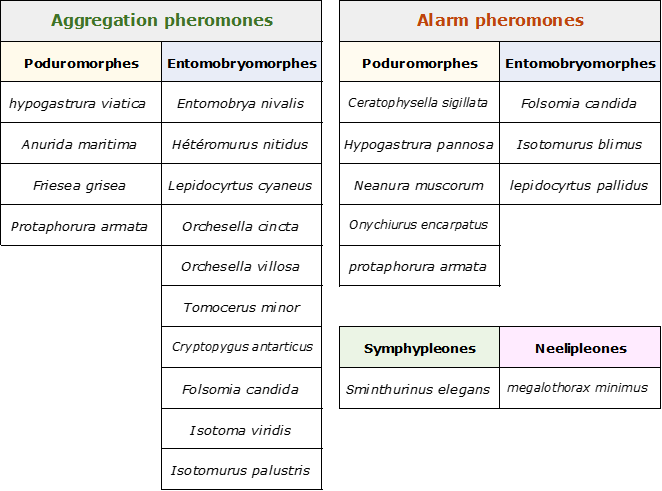
In the case of sex pheromones produced by females, the latter condition the deposition of spermatophores by males. At the same time, pheromones emitted by males during spermatophore deposition also have an attractive power on females.
It is shown that the preference of springtails for certain foods (fungal) as well as the selection of the latter can be carried out by olfactory perception even when the springtail has not yet consumed this food. An attraction to a given food results in rapid directional movements towards the source of the smell at a distance ranging from one to forty centimeters. This attraction is followed by a stop of movements in the presence of food.
Note: various studies (6-7) showthat the volatile compounds emitted by certain bacteria are perceived by springtails. A significant example is revealed through this characteristic smell that takes the earth wet by the rain. It is due to the petrichor (substance secreted by some plants) that remains in the soil. One of the components of petrichor is geosmin produced by bacteria called streptomyces. Laboratory experiments with six species of springtails have shown that the olfactory perception of geosmin allows them to remotely detect one of their favorite foods, streptomyces. This communication, which seems to be to the benefit of springtails, highlights a symbiotic relationship that also turns out to be to the benefit of streptomyces. Indeed, by consuming these bacteria, springtails spread their spores (stuck to their body or from their faeces) in parallel when they move. What seeds newterritories and ensure the survival of new colonies of streptomyces. We measure the essential role of springtails in the life cycle of streptomyces, which are one of the most important sources of antibiotics known. Indirectly we are therefore indebted to springtails...
In addition, the odours emitted by animals living in the soil can also be detected remotely by certain springtails. This is the case for earthworms (8) whose mucus and droppings (urine) could be perceived by heteromurus nitidus as a signal indicating a possible food source. The researchers measured a greater distribution of these springtails in correlation with the density of earthworms evolving in these soils. Odours emitted by other predatory insects can also be interpreted as warning signs.
All these olfactory chemical exchanges, whether attractive, neutral or repellent, condition the relationship between the different organisms and the soil. For example, they impact the arthropod/fungal relationship and probably play a significant role in the dissemination and regulation of fungal populations, which alone represent nearly six times more than the biomass of the animal kingdom and come third in the kingdoms of life.
Iwill only take up very briefly the chemical elements which go into the composition of pheromones, because their study calls for concepts that are too complex in this popularizing context.
However, it can be remembered that most pheromones produced by insects and springtails are madeupof different molecules in varying proportions depending on the species and within a given species. Thus, sex and aggregation pheromones are composed of alcohols, esters (resulting from reactions between alcohols), amino acids (constituents of proteins), fatty acids (necessary for physiological functions), aldehydes (promoting the diffusion of odors) and ketones.
All these elements represent a wide olfactory spectrum depending on their respective contents within pheromones, which opens up to thex different animal species an equally wide discriminative spectrum. This spectrum offers them a high precision of perception as well as a fine adaptation between the transmitter and the receiver of the chemical message.
Alarm pheromones and necromones generally consist of aromatic compounds (molecules that can have a strong odor, constitutive of the substances released by the fragrance of flowers) or fatty acids. For example, the researchers were able to release linoleic acid from springtail pheromones. This acid has the particularity of being an effective repellent against ants that are predators or aphids, beetles and woodlice.
Conclusion :
The study of pheromones and chemical compounds and, more generally, that of communication between living organisms promises spin-offs that will increasingly impact a large number of agricultural practices. Work on the olfaction of insects arouses interest linked to the potential they suggest for the protection of crops via techniques of "olfactory disturbance". Manufacturers have already explored these ways to put in place means of pest control. For example, the technique of "sexual confusion" consists in saturating the environment with sexual pheromones to confuse the male so that he does not find his female, which has the effect of hindering his reproduction. Thanks to their specificity, the use of sex pheromones makes it possible to precisely target a given insect (box tree moth, processionary caterpillar, fruit fly, etc.). The pheromones exploited in agriculture suggest a range of alternatives to chemical treatments, the benefit/harm ratio of which proves to be increasingly poor every day.
Sources :
- « Chemical communication in springtails: a review of facts and perspectives» Sandrine Salmon, Sylvie Rebuffat, Soizic Prado, Michel Sablier, Cyrille d'Haese, Jian-Sheng Sun, Jean-François Ponge
- Chimiorécepteur d’après « la communication chimique chez les animaux-Rémy Brossut-1996 »
- Podura aquatica-Mare temporaire alt.1800m-Massif des trois Seigneurs-Ariège. © Philippe Garcelon
- "The role of chemical communication in interractions between collembolan species". Sandrine Salmon, Marie Salomon-Mallet, Michel Sablier, Soizic Prado, Cyrille d’Haese, Jean-François Ponge, Anjelica Lecomte, Clémentine Le Gall. (Communication effectuée à l'occasion du 10ème "Séminaire international des aptérygotes" (ISA10), Paris, France-2019)
- Colonne de fourmis ©Sue Robinson.
- Schéma : Dale Purves, G-J Augustine, D. Fitzpatrick, W-C Hall, LaManta, McNamara, Williams, Neurosciences, De Boeck, 2005, 811 p..
- « Developmentally regulated volatiles geosmin and 2-methylisoborneol attract a soil arthropod to Streptomyces bacteria promoting spore dispersal»Paul G Becher, Vasiliki Verschut, Maureen J Bibb, Matthew J Bush, Béla P Molnár, Elisabeth Barane, Mahmoud M Al-Bassam, Govind Chandra, Lijiang Song, Gregory L Challis, Mark J Buttner, Klas Flärdh
- « Collembolan dietary specialisation on soil grown fungi » - November 2003 - Biology and Fertility of Soils39(1) :9-15
- Sandrine Salmon, Jean-François Ponge. Les excréments de vers de terre attirent les collemboles du sol : expérimentations en laboratoire sur Heteromurus nitidus (Collembola : Entomobryidae). Biologie et biochimie des sols, Elsevier, 2001, 33 (14), pp.1959-1969. ff10.1016/S0038-0717(01)00129-8ff. ffhal-00501867ff